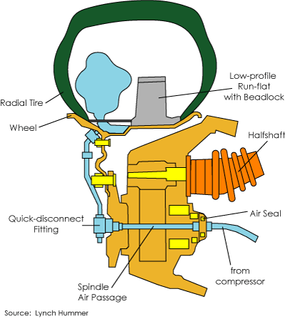Central Tire Inflation System
The idea behind the CTIS is to provide control over the air pressure in each tire as a way to improve performance on different surfaces. For example, lowering the air pressure in a tire creates a larger area of contact between the tire and the ground and makes driving on softer ground much easier. It also does less damage to the surface. This is important on work sites and in agricultural fields. By giving the driver direct control over the air pressure in each tire, maneuverability is greatly improved.
Another function of the CTIS is to maintain pressure in the tires if there is a slow leak or puncture. In this case, the system controls inflation automatically based on the selected pressure the driver has set.
Advertisement
There are two main manufacturers of the CTIS: U.S.-based Dana Corporation and France-based Syegon (a division of GIAT). Dana Corporation has two versions, the CTIS for military use (developed by PSI) and the Tire Pressure Control System (TPCS) for commercial, heavy machinery use.
CTIS: Inside
Here is a look at the overall system:
A wheel valve is located at each wheel end. For dual wheels, the valves are typically connected only to the outer wheel so the pressure between the two tires can be balanced. Part of the wheel valve's job is to isolate the tire from the system when it's not in use in order to let the pressure off of the seal and extend its life. The wheel valve also enables on-demand inflation and deflation of the tires.
An electronic control unit (ECU) mounted behind the passenger seat is the brain of the system. It processes driver commands, monitors all signals throughout the system and tells the system to check tire pressures every 10 minutes to make sure the selected pressure is being maintained. The ECU sends commands to the pneumatic control unit, which directly controls the wheel valves and air system. The pneumatic control unit also contains a sensor that transmits tire-pressure readings to the ECU.
An operator control panel allows the driver to select tire-pressure modes to match current conditions. This dash-mounted panel displays current tire pressures, selected modes and system status. When the driver selects a tire-pressure setting, signals from the control panel travel to the electronic control unit to the pneumatic control unit to the wheel valves.
When vehicles are moving faster (like on a highway), tire pressure should be higher to prevent tire damage. The CTIS includes a speed sensor that sends vehicle speed information to the electronic control unit. If the vehicle continues moving at a higher speed for a set period of time, the system automatically inflates the tires to an appropriate pressure for that speed.
This type of system uses air from the same compressor that supplies air to the brakes. A pressure switch makes sure the brake system gets priority, preventing the CTIS from taking air from the supply tank until the brake system is fully charged.

A Closer Look
Here is what happens on the road: The electronic control unit tells the pneumatic control unit to check current pressure and either inflate or deflate the tire to the pressure selected by the driver. If the system determines that inflation is needed, it first checks to make sure that brake pressure reserves are where they should be; if they are, it applies a slight pressure to the wheel valve to allow inflation. If the tires are overinflated, the system applies a slight vacuum to the wheel valve. When the pneumatic control unit reads that the appropriate pressure is reached, the valve closes.
In this illustration, you can see the pathway that the air travels for inflation or deflation once it gets to the wheel. The tubing runs from the vehicle's air compressor through the wheel hub and then to the tire valve. The "quick disconnect fitting" allows the tire to be separated from the CTIS system for removal or servicing. (This diagram also shows the Hummer's run-flat feature, which allows the tire to continue supporting the vehicle even when it will not hold any air.)
